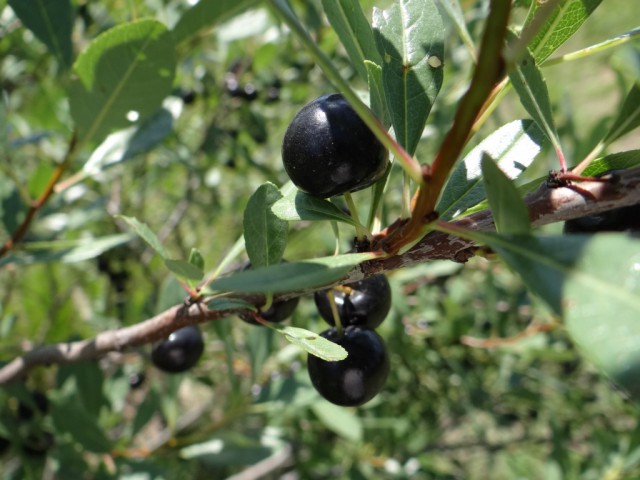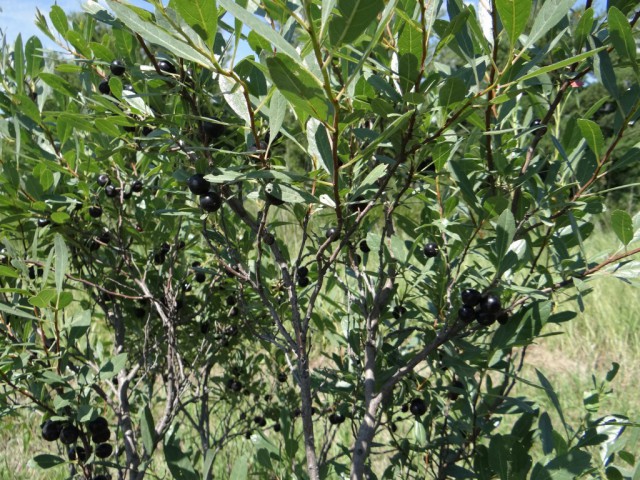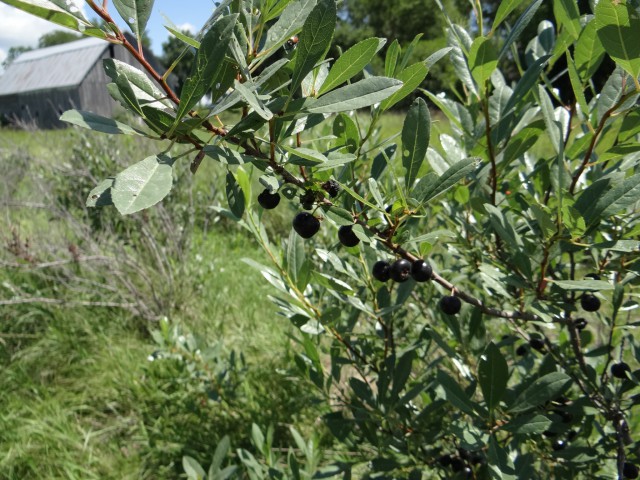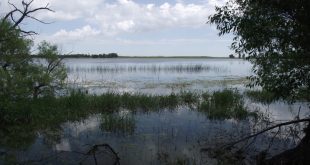I’m all about wild edibles, especially wild fruits, and they are a prominent feature of Nebraska in the summertime. One of the not-so-common wild fruits to harvest in early summer is actually one of my favorites – the sand cherry. And, some are ripe!
The western sand cherry, Prunus besseyi, is a native plant. It is a low shrub and a member of the rose family, Rosaceae.
This plant was first identified and given a Latin name by botanist Charles Edwin Bessey (1845-1915). The name should ring a bell. The U.S. Forest Service’s Bessey Ranger District that encompasses the Nebraska National Forest near Halsey and Samuel R. McKelvie National Forest near Valentine bears his name, as does the Bessey Tree Nursery at the forest near Halsey.
Known as the Bessey’s cherry, American cherry or beach plum, Native Americans consumed sand cherries ripe and fresh off the bush, but also dried them for later use. Early settlers also discovered the flavor of the sand cherries and featured them in many things such as pies, jellies, jams, syrups and wines. It was said that sand cherry pie was a pioneer favorite! In fact, the western sand cherry fruit remains prized for consumption today. Sand cherry fruit is usually dark purple to black in color, indicating high anthocyanin levels, which suggest high antioxidant levels. Ripe sand cherries are also consumed by many wildlife species, so please don’t take more than you can use.
Growing mainly in well-drained, sandy or sandy-loam soils along various rivers and in the Nebraska Sandhills, the western sand cherry is a hardy, very drought tolerant plant that needs full sun or light shading but doesn’t require much water. In many parts of the state the sand cherry has either been transplanted or planted in gardens, orchards and acreages. The sand cherry has also been planted around farmsteads as windbreaks.
The western sand cherry, which produces seed at 2 or 3 years of age, is not known for living long though and seldom reaches the age of twenty. In late spring sand cherry branches are covered with pretty, white, one-half inch flowers that are pollinated by insects. The one-fourth inch, cherry-like fruits change from reddish to purplish and then black.
Each fruit contains one fairly large seed or stone. These seeds are dispersed by birds and animals and can readily sprout where dropped.
My wife Polly has found the juice of the western sand cherry fruit, although tart and pucker-inducing, to be a flavorful addition to any fresh fruit drink. Mixing sand cherry juice with orange or blueberry juice blended with ice and milk creates a nutritious and delicious smoothie. Polly likes to mix the juice with exotic flavors like banana, mango, kiwi, papaya, etc. to get a quick shot of energy while enjoying the intense fruit flavor. She says be careful the juice can stain. You can keep sand cherries in the refrigerator for about a week, and they can also be dried or frozen.
Need a recipe for sand cherries? Here’s a simple, but scrumptious one for you to try that has been passed down from preceding generations of my Nebraska pioneer family.
Wagner’s Sand Cherry Pie
1 qt fresh, ripe, pitted western sand cherries
1 cup sugar
1 cup cream (heavy cream or half and half)
2 tbl flour
Combine sugar and flour, then add cream (heavy cream or half and half) and pour over berries in an unbaked pie crust. Add top crust and bake at 375 degrees about 40 minutes.
So, check with a friend, relative or co-worker who may own land where sand cherries grow, and wouldn’t mind you picking a batch. Offer them a tasty sand cherry pie as a trade!
 Nebraskaland Magazine
Nebraskaland Magazine







